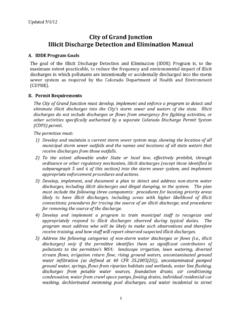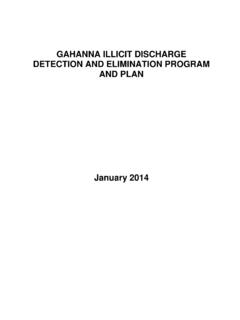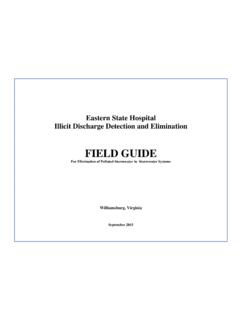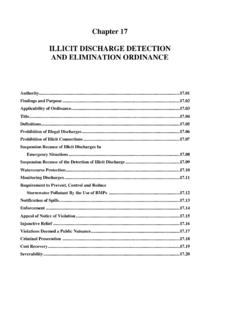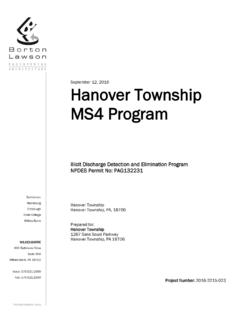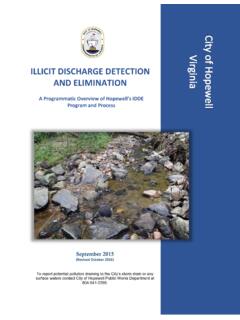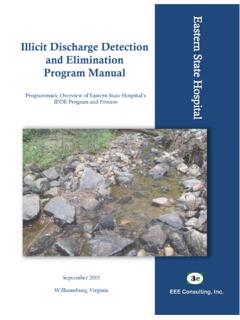Transcription of Chapter 5 Illicit Discharge Detection and Elimination
1 Gowanus Canal8990 Chapter 5 Illicit Discharge Detection and Elimination (IDDE) Municipal Separate Storm Sewer Systems of New York City SPDES Number: NY-0287890 August 1, 2018 9192 Under Part of the MS4 Permit, the City must develop, implement, and enforce a program to detect and eliminate Illicit discharges into the MS4. Illicit discharges are non-stormwater, unauthorized discharges to the MS4. This Chapter describes the City s Illicit Discharge Detection and Elimination (IDDE) Program, which can rely on existing programs, to satisfy the following MS4 Permit requirements: Prohibit Illicit discharges into the MS4 through appropriate enforcement procedures and actions; Establish a procedure for determining whether non-stormwater discharges are significant contributors of pollutants to Surface Waters of the State; Detect and eliminate unauthorized non-stormwater discharges into the MS4, including spills and illegal dumping; Conduct a routine outfall reconnaissance inventory.
2 Prioritize waterbodies that are shown through sampling activities to have fecal coliform levels over 200 colonies/100 (milliliters) mL for mini-shoreline investigations; Educate public employees, businesses, and the general public about the hazards associated with illegal discharges and improper disposal of waste; Describe procedures to prevent, contain, and respond to spills that may Discharge to the MS4; Describe controls to limit infiltration of seepage from municipal sanitary sewers to the MS4; and Train staff who implement IDDE 1: Legal Authority and Program Administration discusses the City s legal authority for the IDDE Program and details the City s regulatory mechanisms to prohibit Illicit discharges into the City s sewer system.
3 Appendix : Enforcement Response Plan (ERP) describes procedures for investigating, documenting, and enforcing against Illicit discharges pursuant to Part of the MS4 Permit. All City agencies that own or operate facilities within the MS4 area conduct IDDE activities on their property, while DEP conducts IDDE activities citywide. To assist agencies, DEP has developed an a NYC IDDE Agency Guidance Manual on how to track, eliminate, and report Illicit discharges. Existing ProgramsThe City has long-standing, effective programs for detecting, identifying, and eliminating Illicit discharges citywide:Shoreline SurveyThe Shoreline Survey Program is an outfall reconnaissance inventory that identifies and characterizes shoreline outfalls in NYC.
4 Under this program, 100 percent of the shoreline is surveyed every ten years, with progress made each year. If a dry weather Discharge is observed, DEP conducts an investigation to track down the source and takes steps to abate the Monitoring ProgramThe Sentinel Monitoring Program monitors waterbodies throughout NYC for pathogens. Under this program, DEP collects samples at 80 monitoring stations on a quarterly basis. DEP compares results to a NYSDEC-established water quality baseline. If sampling results are above the baseline limit of 200 colonies/100 mL, DEP investigates the adjacent shoreline through a mini-shoreline survey to determine whether there is a contaminated dry weather Discharge that would require source trackdown and abatement actions.
5 Figure shows the results of the DEP Shoreline Survey and Sentinel Monitoring Programs over the past 19 Survey ProgramThe Harbor Survey Program samples ambient waterbody stations to assess the health of waterbodies throughout NYC. DEP coordinates the review and analysis of this data among the various monitoring programs, and it may be used to initiate a mini-shoreline survey. Chapter 10: Monitoring and Assessment of Controls, Section , describes the City s other existing water quality monitoring provides a mechanism for the public to report Illicit discharges to the City. Waterway complaints, illegal dumping, and oil spills are examples of reports the public can make through 311.
6 The City responds to 311 reports based on the type of complaint. For more information on 311, refer to Chapter 2: Public Education and Spill ResponseThe Emergency Spill Response Units in DEP and FDNY respond to spills citywide. DEP responds to spills that enter the City s sewer system 24 hours a day/7 days a week. The FDNY Hazmat Unit and the DEP Division of Emergency Response and Technical Assessment (DERTA) respond to hazardous materials spills. DSNY may assist in spill response upon request by emergency response staff. Non-Stormwater DischargesNon-stormwater discharges into the MS4 are generally not authorized and are considered Illicit .
7 However, certain non-stormwater discharges into the MS4 are allowed, including those from firefighting activities, and discharges determined not to be significant contributors of pollutants to Surface Waters of the State by DEP. Pursuant to 15 Section 19-02(j), DEP determines whether a non-stormwater Discharge is a significant contributor of pollutants on a case-by-case basis, and the Discharge must be approved by the DEP Commissioner. Discharges DEP considers to be significant sources of pollutants and any other non-stormwater discharges into the MS4 such as sanitary connections to storm sewers, illegal dumping, and spills that enter the sewer are considered Illicit .
8 The City engaged targeted stakeholders to discuss the IDDE Program. These stakeholders included: General Public Stormwater Advisory Group Community Boards and Elected Officials in the Coney Island Creek watershed Neighborhood Associations in the Coney Island Creek watershed Environmental organizations Community groups and non-profit partners The public requested access to additional water quality data and information on IDDE investigations, information on how to report potential Illicit discharges, and information on how to receive notifications of Illicit discharges. The City: Began posting the Sentinel Monitoring Program quarterly data and the annual Sentinel Monitoring Reports which summarize IDDE field investigations.
9 Created new guidance on how to report potential Illicit discharges through 311. Began notifying elected officials, community boards, and community leaders when Illicit Discharge sources are million gallons per day (MGD) 97. 5 7 %DEP has successfully abated the overwhelming majority of discovered Illicit million gallons per day (MGD) Program Effectiveness Between 1998-2017 Shows the effectiveness of existing DEP programs at identifying and eliminating Illicit discharges through the Shoreline Survey and Sentinel Monitoring dumping occurs when material, including but not limited to bags, litter, oil, unused concrete, concrete wash waters, construction debris, and appliances, is dumped onto surface drainage ways, open channels, storm inlet/catch basins, or storm manholes on public or private property.
10 It is illegal to dump, deposit, or otherwise dispose of any dirt, sand, gravel, clay, loam, stone rocks, rubble, building rubbish, sawdust, shavings, trade or household waste, ashes, manure, garbage, rubbish, or debris of any sort being transported in a dump truck or other vehicle in or upon any street, lot, park, public place, or other area whether publicly or privately owned. In addition, no person may allow anyone under his/her control (agent or employee) to engage in illegal dumping. Penalties for this offense include a fine and vehicle Illicit Discharge Detection DEP is continuing its Shoreline Survey and Sentinel Monitoring Programs in order to meet the outfall reconnaissance inventory and water quality sampling requirements of the MS4 Permit.










